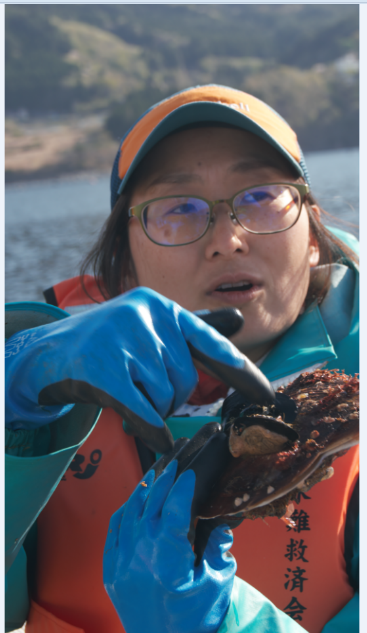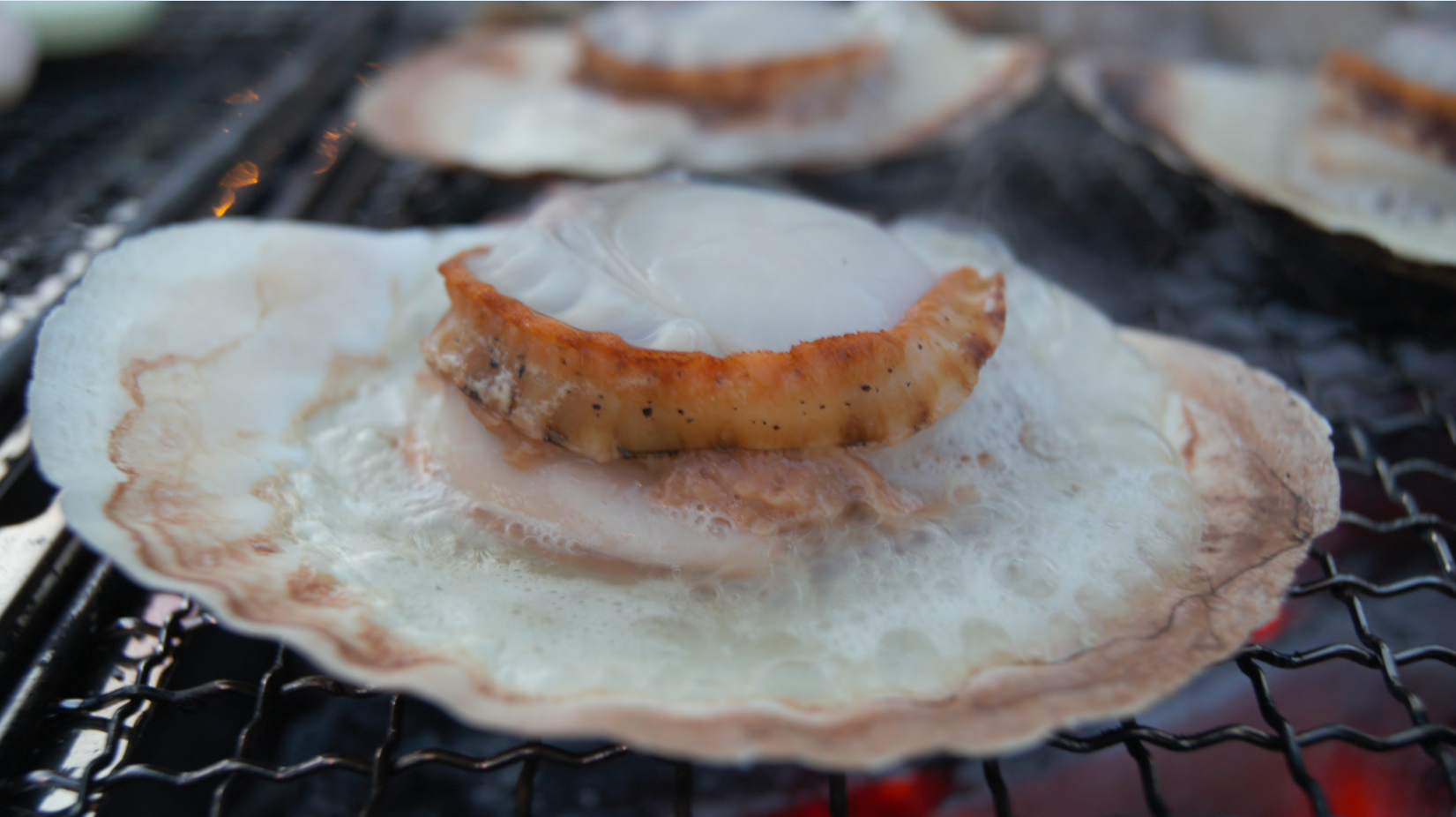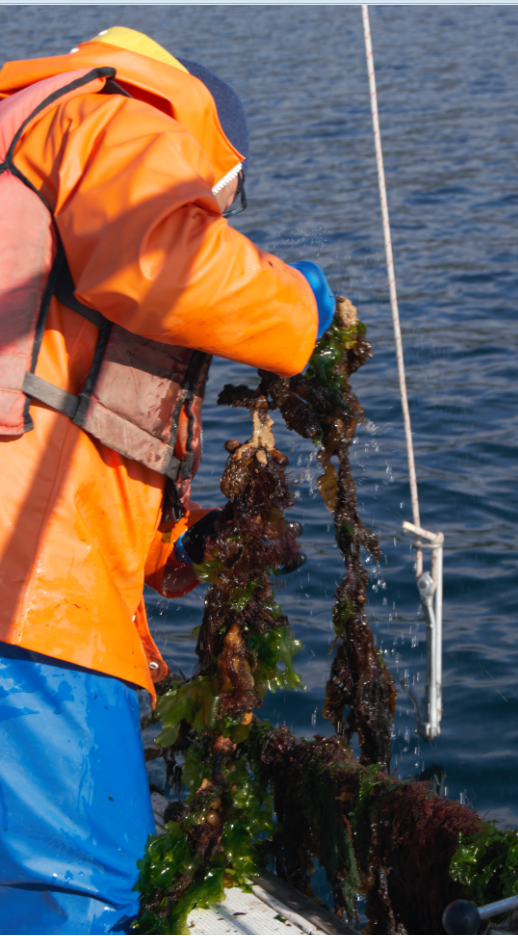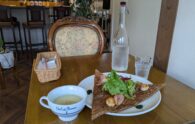You may have heard me say multiple times, but the city of Ofunato prides itself as the city that supplies one of the finest seafoods. One of the major reasons is due to the convergence of two major ocean currents off the coast of Iwate, which helps maintains the abundant supply of minerals and nutrients that enriches the quality of the seafood caught around this area. No wonder this “Sanriku Area” is widely known as one of the world’s top 3 fishery points. Another key factor is Ofunato’s large bay along with its equally large harbors that helps sustain the quality and quantity of aquaculture raised seafood in which Ofunato supplies to the community.

Although this may not be known on a global scale, Ofunato is largely known for its Pacific Sauries, Scallops, Seaweeds, Sea Urchins, and Oysters in Japan. Putting aside the Pacific Sauries for now, the rest are commonly known to be seafood that can be farmed and grown through aquaculture. So, then a few questions arise: Isn’t that true for the neighboring coastal cities? Than what makes Ofunato’s aquaculture farmed products so different?
What separates Ofunato from the rest is simply the size of Ofunato’s bay. The width, length, and deepness of this bay is incomparable to those nearby. Additionally, the size along with the bay’s small mouth softens the waves creating a prime condition for aquaculture. Additionally, the mountainous terrain that covers much of Iwate also helps to provide rich minerals into the bay as it rains, allowing for a natural cycle that enriches the quality of the seafood farmed in the bay. Lastly because of this geographical advantage, the history behind the aquaculture within this city is very deep, and so what we will be focusing on today is exactly that, Ofunato’s highly prized scallop farming culture. And what’s more than learning about the scallop aquaculture that Ofunato has to provide is to learn about them from the people which actually work to farm them!
Today’s interview is with Mrs. Okada, who has moved to Ofunato approximately 3 years ago and have been actively working as a fisherwoman since!
Me: First and foremost, may I ask for a short introduction about yourself?
Okada-san: Of course. My name is Mayumi Okada, and I have moved to Ofunato through the 地域おこし協力隊 (AKA: Local Revitalization Cooperation Group) about 3 years ago. My husband and I had different jobs previously, but after seeing off our daughter live on her own, we had shifted our future towards aquaculture, specifically in the field of shellfish, which has been our interest for some time.
*地域おこし協力隊, or Local Revitalization Cooperation Group is a program provided by the government that has been growing the recent years. The main purpose of this program is to encourage young people to move to and work in rural and less-populated areas of Japan, and to revitalize these regions by injecting fresh energy, skills, and enthusiasm into local communities.


Me: Wow, so using this government program, you had chosen to pursue a totally different field in the rural part of Japan! So, if I may ask, what exactly do you do?
Okada-san: Right now, our main products are Scallops and Wakame seaweed, and in additionally I am helping to support and revitalize the city’s fisheries department. The aquaculture part I assume we will touch upon later, so add some details in regards to helping the fisheries department, I am currently organizing hands-on fishery activities for tourist, helping and connecting necessary organizations to create a supplemental network.
Me: So I know Ofunato provides many kinds of seafood, but from your perspective what is the Top 3 and why?
Okada-san: Well, this may just be me playing favoritism, but If I were to name the top three it would be Wakame Seaweed, Scallops, and lastly Sea Urchin. Raising these products in the ocean that changes each year gives both hardship and joy and because of that makes it tastes all the more delicious. The reason why the fishermen here raise these kinds of seafood is due to the convergence of the two ocean currents which provide the natural nutrients within the surrounding area. Additionally, due to the minerals and nutrients which trickle down from Mt. Goyo, Mt. Okubo, Mt. Natsumushi, and Mt. Imade, all three which are renowned mountains within Ofunato. These conditions not only maintain but also increase the quality of the seafood caught in the area when compared to those caught in the neighboring cities.

Me: Ah, so the natural geography does indeed help the fisheries in Ofunato. So, knowing that you farm scallops for a living, would you help provide some insight regarding scallop farming in general or scallop farming in Ofunato?
Okada-san: Ah, understood. So generally, scallops are shellfish which stay in the sandy parts of the sea floor, similar to clams. As such, usually these kinds of shellfish have a lot of sand in them and need some time for them to spit out the sand before they are prepared as a meal.
But when scallops are farmed there is a special process called Mimizuri or “Ear-Hanging,” where they tie a rope through the scallops’ ear and later hung in the middle layer of the ocean after they have grown to a certain size. By doing so, the scallops are able to feast on planktons which reside more in the mid-layer rather than the ocean floor, allowing the scallops to grow bigger. Of course, since they are not in the ocean floor they will not contain sands, and the meat of the scallops become bigger compared to those that are not grown this way. I for one think that this process makes the scallops slightly sweeter and better tasting.


Now the reason why I explain this Mimizuri procedure is one, because it is a key process, but also because it is said that this procedure was born and started here in Ofunato. Unfortunately, I personally don’t know of the specifics other than the fact that this procedure was established in 1961, but you can see that Ofunato has put in many time and effort to establish and maintain the scallop farming culture. Before I had mentioned the geographical advantages that Ofunato has, not only because I work as on this side, but we should also thank and be grateful for the efforts that has been put into these products by the fishermen.
Me: Thank you very much for sharing such valuable information with me and well as the readers today. In finishing our interview today, would you have any last remarks for the those who may read this?
Okada-san: Thank you too Taiga-san. Yes, if I may. The seafood available in Japan has historically varied per season. With modern technologies these days, the varieties available may have grown immensely and they are very delicious regardless. Even farmed seafood have their seasons, and you’ll most definitely be surprised by its taste. As such, whenever you have the chance, I hope you will come visit Ofunato and experience the seasonal treasures in addition to the fishermen, ocean, and the farm where these products grow.
If you have any interest in Scallop farming or seaweed farming, I personally do hands-on tours with tourist so please feel free to contact me!
Me: Okada-san, thank you very much once again for such a wonderful time. The visual impact or tasting something delicious and sharing its greatness is one thing, but I always feel that “knowing” the history and/or the process in which the food is prepared changes the perspective of how you see or taste it. I too hope people will come visit Ofunato and experience the core of its greatness!

Japanese
大船渡のホタテ養殖について (インタビュー)過去にも何度かお話したことがあるかもしれませんが、大船渡市は新鮮かつ上質な海産物を提供する市として誇りを持っています。その主な理由として、三陸沿岸は沖合で2つの海流が交わる箇所であり、それによって、その近辺の栄養分が豊富であり、海産物の品質は非常に高いとされています。そういった条件もあり、三陸海域は世界のトップ3の漁場の1つとして広く知られています。加えて、大船渡市の大きな湾と大きな港も地域に提供する海産物の品質と量を維持するのに大きく貢献しています。
世界規模で浸透していないかもしれませんが、日本国内では大船渡はサンマ、ホタテ、ワカメ、ウニ、カキといった海産物で知られています。サンマについては一旦置いておきますが、その他の海産物は一般的に養殖可能な魚介類です。となると、疑問が浮き上がりませんか?「隣接する沿岸都市も同じなのではないか?」、あるいは「大船渡の養殖製品は他とどう違うのか?」など。
大船渡市が他の沿岸都市と違う大きな点の一つは、大船渡湾の大きさです。この湾の幅、長さ、深さは、近隣のものと比較できないほどです。また、湾の小さな入り口は波を和らげ、湾内での養殖に最適な状態を実現しています。さらに、岩手県の大部分を覆う山岳地帯は、雨が降ると湾に豊富な栄養を供給し、海産物の品質を豊かにする自然な循環を生み出します。この地理的な利点も相まって、この市内の養殖に関する歴史は非常に深いです。今回の記事では大船渡で高く評価されているホタテについて焦点を当てようと思います。大船渡が提供するホタテについて学ぶためには、実際にホタテを養殖する人々から学ぶのが最適な方法でしょう!
ということで、今回の記事は大船渡市に3年ほど前に移り、漁師としてご活躍している岡田さんとのインタビューをお届けします。
私: まず初めに、簡単な自己紹介をお願いできますか?
岡田: もちろんです。私の名前は岡田真由美(おかだ まゆみ)と言います。約3年前に「地域おこし協力隊*」(通称:地域振興協力団体)を通じて大船渡に引っ越してきました。私たち夫婦はそれまで全然違うお仕事をしていましたが、娘が独り立ちした後、長い間興味を持っていた貝類の養殖に取り組みたいと思い、移住しました。
*「地域おこし協力隊」または「地域振興協力団体」とは、政府が提供しているプログラムで、近年成長してきたものです。このプログラムの主な目的は、若い人々に日本の農村地域や人口の少ない地域に移住し、地域コミュニティに新しいエネルギーやスキル、熱意を注入することで、これらの地域を活性化することです。
私: へぇ、それでこの制度を利用して、日本の農村地域でまったく異なる分野に進むことを選ばれたのですね!では、もしお尋ねしても良ければ、具体的にどのようなことをなさっているのですか?
岡田: 現在、私たちの主要な生産品はホタテとワカメでして、さらに、私は市の水産業をサポートし、活性化するお手伝いをしています。養殖については後で詳しく触れるので割愛しますが、水産業のサポートについては、主に漁師による漁業体験やその海産物(お土産)による地域のファン作りを目標にその基盤づくり(地域の漁師や関係団体の理解、協力体制の構築)を行っています。
私: なるほど!それでは少し話が変わりますが、大船渡は多くの種類の海産物を提供していることは知っているのですが、岡田さんにとっては大船渡市のトップ3の海産物は何ですか?
岡田: これは本当に私の好みかもしれませんが、もしトップ3を挙げるなら、ワカメ、ホタテ、そして最後にウニですね。これらの海産物を年々変わる海で育てる苦労と喜びもありますが、味わいはそれだけに、一層美味しいと感じます。後はそうですね、大船渡市の漁師がこれらを育てる理由は、この三陸沖に寒流(親潮)と暖流(黒潮)がぶつかる潮目があり好漁場となっていることや、大窪山、夏虫山、五葉山、今出山など山からの栄養分が川から海へ流れ込み豊かな漁場を形成しているためです。これらの条件は、近隣の都市で育てられる海産物と比較して、この地域で上げられる海産物の品質を維持するだけでなく、向上させているため、大船渡市で養殖された海産物は絶品だと思っています。
私: それほどまでに沿岸の地形は漁業に役立っているんですね。さて、岡田さんはホタテ養殖を行っていると仰っていましたが、ホタテ養殖について教えて頂いても宜しいでしょうか?
岡田: もちろんです。ご存知の通り、ホタテは貝類でして、本来であればアサリのように海底の砂地にいます。そのため、砂が多く含まれ、食事として提供する過程に砂を抜く必要がありますし、場合によっては完全に抜くことは難しかったりします。
しかし、ホタテ養殖の場合、「耳吊り」といった過程があります。ホタテがある程度大きく成長した後、耳にロープを通し、海中に吊すものです。こうすることで、ホタテは海底に比べて多くのプランクトンが生息する中層で育つため、通常より大きく成長することが可能になります。もちろん、海底にいないので砂は含まれませんし、この方法で育てられたホタテはそうでないものと比べて貝柱が大きくなり、更には、個人的な感想ですが、耳吊りをすることによってホタテが甘く、美味しくなると思っています。
さて、なぜ私がこの耳吊り手法を説明するのか、その理由は、ホタテ養殖では重要な過程というのもありますが、この手法の開発者であり生誕の地が大船渡であると言われているからです。残念ながら、昭和36年頃にこの養殖方法が確立された以外の詳細は知らないのですが、大船渡がホタテ養殖文化を確立し、維持するために多くの時間と努力を費やしてきたことが分かります。先ほど話した大船渡の地理的な利点だけでなく、私がこの分野で働いているというのもありますが、この地の漁師たちがこれらの海産物の生産に尽力していることを再認識することが大事だと思っています。
私: このような情報を私に、そして読者の皆様にご教示いただきありがとうございます。
最後に読者に対してコメントを頂いても宜しいですか?
岡田: このような機会を頂きありがとうございます。
そうですね、日本の海産物は四季折々。いつもおいしい海産物ですが、養殖物にも実は旬があって、その旬をとらえるとまた違ったおいしさに出会えます。是非大船渡に足を運んで、四季折々の旬に出会ってください。そしてそれを生産されている漁師さんに、海に、生産現場にいらしてください。また違った感動に出会えると思います。
また、もしホタテ養殖やワカメ養殖の漁業体験にご興味があれば遠慮なくご連絡ください!
私: 岡田さん、改めましてお時間いただきありがとうございます。確かに見た目や味を堪能し、その美味しさを分かち合うことは醍醐味の1つですが、その歴史や思いを「知った」上で堪能すると更なる感動を経験できると私も思います。国内だけではなく、海外の方々にも大船渡に来ていただき、その良さを知って欲しい限りですね!



